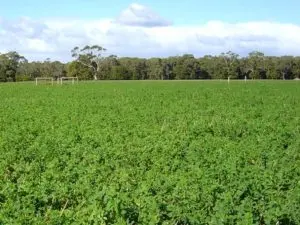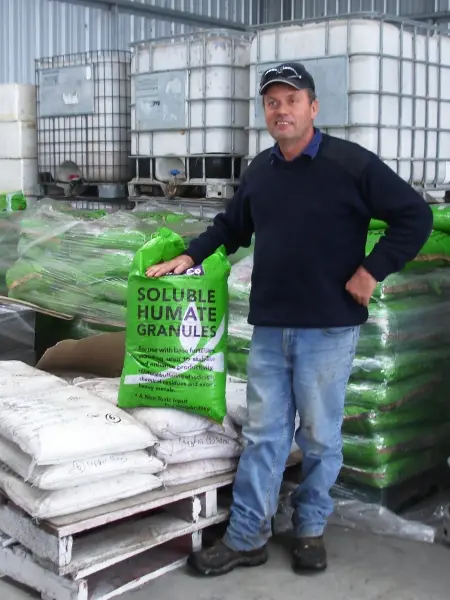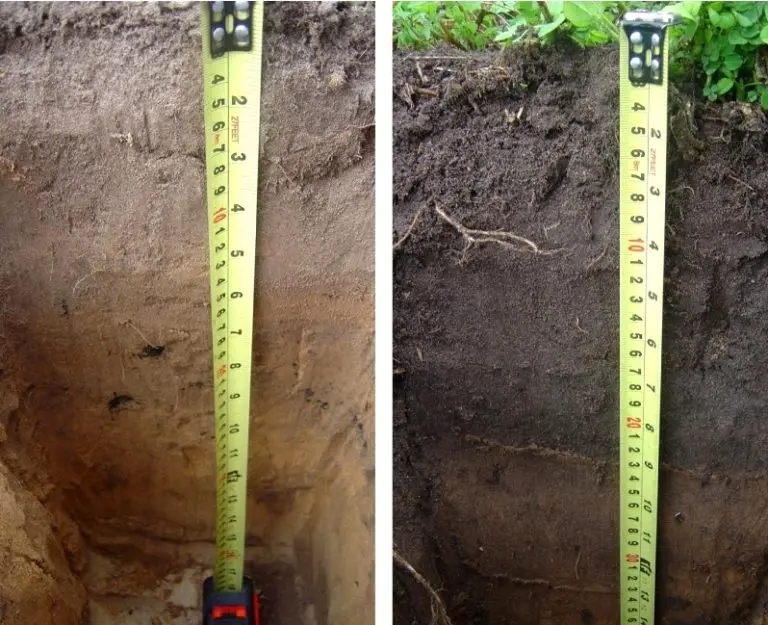David Clayfield has used applied soil science to create fertile, healthy soils from sand, in turn producing healthy pastures and healthy cows.
Faced with rising production costs and animal health concerns, David Clayfield made the link that improving soil health – physically, chemically and biologically – could address the cause of animal health and low productivity problems.
David eliminated the use of chemical and acid-based fertilisers, replacing them with biologically-based soil conditioners tailored to rectify deficiencies identified through soil tests.
Fifteen years on, yellow sands have turned into dark, healthy soils with a substantial increase in soil organic matter. Irrigation requirements have reduced from the region’s typical seven to eight megalitres per hectare each year to five to six, subsequently reducing the energy used for pumping and distribution.
Pastures are thriving, animal health has improved and productivity has increased, while the veterinary bills have plummeted – positive results, all round.

Background
CLOVER ESTATE
David’s grandfather came to Clover Estate in the mid 1930s to manage a large grazing estate. He bought a portion of it when the estate was subdivided for soldier settlement blocks after World War II. David’s father grew up on the farm and has now retired, leaving David to run the property.
The typical soil in the region is five metres of sand overlying limestone. Native vegetation is low open forest dominated commonly by manna gum (Eucalyptus viminalis), brown stringybark (Eucalyptus baxteri) and blackwood (Acacia melanoxylon). Most of the native vegetation in south-east South Australia has been cleared to make way for farming and plantation forestry, but there is a small remnant left on the Clover Estate property.
There are no surface streams in the limestone plains area of south-east South Australia – rainfall infiltrates into the limestone, which forms an extensive shallow aquifer system. Dairying and cropping in the region depend on pumping irrigation water from this aquifer system.
Clover Estate lucerne pastures which are interspersed with rye grass, clover and plaintain.
David’s grandfather and father operated Clover Estate as a dairy farm for many years, irrigating the pastures using water pumped from the shallow limestone aquifer underlying the property. After the dairy industry was deregulated the property proved to be too small to run viably as a milk producing dairy farm. Since 2000, the farm has been used to raise dairy heifers that are bred elsewhere in the district.
Heifers are reared on contract on a ‘pay for weight gain’ basis. The calves are brought to the property at four to five months age and within one year they have gained about 200 kg, i.e. a young dairy cow. The farm has the capacity to ‘turn off’ 600 to 700 heifers a year.
The current market for these young cows is the Republic of China. The heifers are shipped to China where they are mated upon arrival and begin producing milk before they are two years old.
A total of about 62 hectares of Clover Estate is irrigated and the rest is used for unirrigated grazing and cutting hay to provide feed during winter. A highly modified landscape, almost all native flora on Clover Estate has been replaced with introduced pasture species.

Soil Management
DEFICIENT SANDY SOILS
South-east South Australia is made up of distinct land systems. The main underlying geological formation comprises limestone layers that have produced fertile soil, including the famous ‘terra rossa’ (red earth) soils of the Coonawarra wine region. Scattered in bands across the plains are low wide sand ridges, running roughly parallel to the present coastline. These sand ridges formed along ancient coastlines in the past few million years as the sea level rose and fell and the land surface was uplifted during ice ages. These sandy soils have low natural fertility.
When the large grazing properties were ‘broken up’ for farming and closer settlement, these sandy soil plots were not in demand. The sandy areas in private ownership were used for grazing, rather than cropping.
Clover Estate and many other properties in the area have been used for dairying, irrigated with groundwater pumped from the limestone aquifer, for many years. This groundwater is rich in calcium, which increases pH from natural levels of around 5, that is, slightly acidic, up to 7 to 8, which is slightly alkaline. This change causes nutrient imbalances and encourages growth of Yorkshire fog or velvet grass (Holcus lanatus), a perennial grass. Holcus lanatus is generally considered in Australia to be a weed of saline and waterlogging-prone sites and has little grazing value. The traditional way to redress the nutrient imbalances in the area is to use superphosphate and potash – potassium-rich fertiliser.

In 1992, a soil test showed organic carbon at 2.1%, total cation exchange capacity 3.5, and deficient levels of 17 macro and micro soil nutrients at Clover Estate. Prevailing advice was to continue to apply higher amounts of chemical fertiliser to maintain production. But high chemical and fertiliser inputs and high water use were proving to be financially unsustainable. Furthermore, excessive weed competition had been developing despite regular use of knock-down and selective herbicides. Insecticides were used regularly for red-legged earth mite and other pests.
These problems, high levels of irrigation per animal production unit, on top of recurring animal health issues – mastitis, prolapse, sore feet – and concern about personal exposure to chemicals, led David to investigate more sustainable ways to improve soil and forage quality.
IDENTIFYING THE BENEFIT OF HEALTHY SOILS
“The aim was to start with the soil health, by balancing the mineral and microbial status of soil, and the subsequent benefits in forage quality and animal health would follow.”
David Clayfield with bags of soil treatment used on the property.
David had realised that management of animal health with medicines was only addressing the symptoms of animal health and performance, rather than the causes. Equally, chemical management was only creating recurring problems at extra cost. Conversely, improving soil health and mineral balance and availability in pasture would address the cause of animal health and low productivity problems.
David found that experimentation and mineral supplementation redressed some animal health problems. Success with this process indicated the strong link between animal nutrition and health. This prompted David to undertake further investigation to address animal health problems through the soil and fodder.
David’s aim was to stop using chemical or acid-based fertilisers and pesticides. He wanted to improve soil fertility and water-holding capacity by adding biologically-based stimulants that increase soil organic matter.
He encountered challenges with adopting new methods, the initial impediment being a lack of information about alternatives to the ’single super’ use way of farming. He was required to perform ongoing research, education and trial and error to identify his options and learn more about the links between soil and animal health.
David initially drew on information from Pat Coleby, a practitioner of animal health through soil health, which provided a useful guide. He also attended short courses in different approaches to fertiliser management, increasing his understanding and confidence in soil mineral and microbial management. David notes, “I have utilised interactions with agronomists and soil scientists from biological product supply companies to assist in fertiliser program management and planning”.
David also read widely to supplement the courses and consultation. His collection of reference books include Charles Walters and C.J. Fenzau’s Eco-farm; Arden Andersen’s Science in Agriculture: Advanced Methods for Sustainable Farming; and Pat Coleby’s Healthy Land for Healthy Cattle.
An equally significant challenge was the lack of interest from other farmers, extending even to ridicule of some of the changes made and methods tried.
Regardless, David advises, “Work it out, stick to it, no matter what everyone thinks. With the experience and knowledge now available, you could build carbon and fertility in your soil in much less time than it took us to learn how by trial and error”.
TURNING SAND INTO SOIL
Spraying biological liquid fertiliser.
Understanding the physical, chemical, and biological aspects of soil through applied soils science and putting this knowledge into practice over time, has been the fundamental innovative practice applied at Clover Estate.
“Testing the soil and observing the plants and animals, it became obvious that use of chemicals and acidic fertiliser were not a long-term solution”, David says. He stopped using chemical fertilisers in the mid 1990s, five years before the switch from milking to raising heifers.
“The aim was to start with the soil health, by balancing the mineral and microbial status of soil, and the subsequent benefits in forage quality and animal health would follow.”
The process began with soil testing to assess the situation. Soil treatments were applied with the objective of addressing mineral balance, improve soil biological processes and overall soil fertility specific to paddock soil test results. The key ingredients are residue-digesting fungi and nitrogen-fixing bacteria, including strains of Azotobacter, Bacilus, Pseudomonas, and Trichoderma 1 Nutrients, carbohydrate and minerals are added to enable the bacteria and fungi to multiply in temperature-controlled 5000 litre aquaculture tanks. The minerals included a carbon, humic base to stimulate soil biological processes and organic matter building activity. The resulting brew is applied to the paddocks yearly at 50 litres a hectare.
Microbe brewing.
In addition to soil building programs, a range of bio-fertilisers, such as foliar and fertigated (application through an irrigation system) mineral, microbial, kelp, fish, humic and fulvic fertilisers have been applied over the past 15 years. Leaf tests are taken to identify lacking nutrition, enabling application of nutrients to address imbalance in plants.
Animals’ performance and grazing preference, along with observing the plant species that are growing, are used as an additional guide as to excess and deficit minerals in the soil.
To target these treatments accurately, David has equipped himself with a refractometer, to measure the sugar concentration in plant sap, and other measurement devices and has soil tested by an agricultural laboratory in Adelaide.
In David’s words, the three rules for the soil remediation techniques he has developed and applied are “balance, balance and balance – carbon to nitrogen ratio, calcium to magnesium ratio, etc. … look at the whole picture from soil to human health”.
Healthy Soil Outcomes
The results are evident in the soil profiles of remnant and treated soils. Soil carbon has increased by 45% in the top 150mm, and potentially substantially more at depth. Organic carbon measurements show an increase from 2.07% in 1992 to 2.92% in 2011.
David estimates that, since the mid 1990s, stock output has increased by 33% while he is using 25% less irrigation water per animal weight produced.
As is usual in the region, centre pivot systems are used at Clover Estate to irrigate with water pumped from the shallow limestone aquifer. Centre pivot irrigation uses sprays fitted on a boom that travels in a circle around the centre pivot point. Electric motors are used to drive the wheels that carry the boom. Two such systems operate at Clover Estate, one of about 300 metres radius, covering about 28 hectares, and the other a 330 metres radius, covering 34 hectares. A neutron probe is used to measure soil moisture levels and determine when watering is needed.
Due to the improved structure of the soils, David has found that his total water use is now around 5-6 Ml/ha/year compared with the 7-8 Ml/ha/year commonly used on sandy soils in the region. This is particularly noteworthy in relation to rainfall, with eight of the last ten years receiving below-average annual falls. As well as using less water, David’s energy costs from pumping and driving the boom have halved.
Cessation of chemical weed control and David’s soil management has ensured vigorous growth of preferred pasture species, combined with rotational grazing. The property is fenced into 50 paddocks, ranging from two to six hectares. The rotational grazing cycle also aims to break the life cycle of intestinal gut parasites.
Clover Estate centre pivot irrigation layout.
David highlights, “Pasture plants grow better and there are now a lot fewer weeds. Lucerne varieties that had been abandoned due to poor performance by most typical, chemically managed properties perform exceptionally well on our property. Lucerne, rye grass, clovers, are the predominant species, along with a variety of herbs for balanced pasture. Animal health issues are primarily averted, due to the density and balance of the minerals in our pasture”.
“Strategic use of selected foliar fertilisers… reduces or eliminates sap sucking insects attacking the pasture. We have found also that foliar fertilisers strengthen our desirable forage species, making them more competitive over weeds.”
David believes that “Holistic management includes an appreciation of natural processes and an understanding of applied soil science. If soil biology functions to its best ability, the availability of minerals to plants will be at its best. If animals and people have access to adequate mineral diversity in diet, then disease is less … and performance is better. Our farm enterprise is more profitable, and more enjoyable. We will leave an improved legacy.”
“Our example has inspired other farmers, particularly dairy and graziers, to adopt aspects of soil management as we have. Looking at our soil profile, black to the depth that it is, speaks for itself. Most farmers appreciate that something is different and improved on our property. We are happy to share our journey, as it appears to give confidence to other food producers to take on similar management. Less chemicals affecting the environment, with improved quality of food for consumers is a better outcome than prior to adopting biological farming system.”


